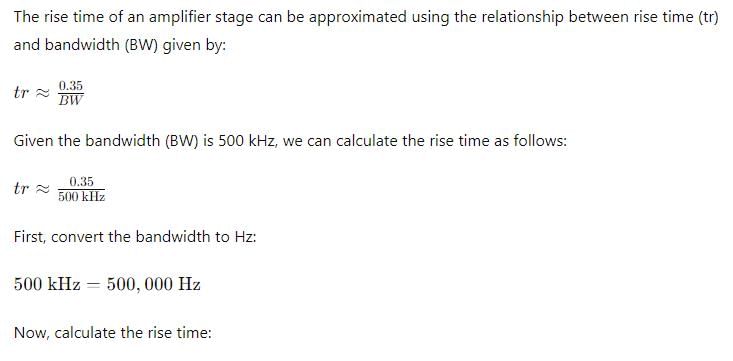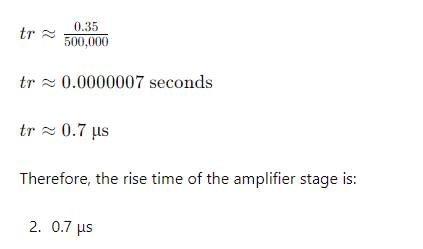Test: Analog Electronics Circuits - Electrical Engineering (EE) MCQ
25 Questions MCQ Test - Test: Analog Electronics Circuits
To prevent a DC return between source and load, it is necessary to use
Thermal runaway will take place if the quiescent point is such that
CE configuration is the most preferred transistor configuration when used as a switch because it
Consider the following statements regarding a common emitter amplifier. It can be converted into an oscillator by:
1. providing adequate positive feedback
2. phase shifting the output by 180° and feeding this phase-shifted output to the input
3. using only a series tuned circuit as a load on the amplifier
4. using a negative resistance device as a load on the amplifier
Which of the above statements are correct?
The PIV rating of the diodes used in power supply circuits are chosen by which one of the following criteria? (Vm is the peak input supply voltage to the rectifier circuit used in the power supply)
An RC amplifier stage has a bandwidth of 500 kHz. What will be the rise time of this amplifier stage?
Consider the following statements in respect of a transistor R-C coupled amplifier:
1. The low frequency response is determined by the transistor junction capacitors.
2. The high frequency response is limited by coupling capacitors.
3. The Miller capacitance reduces the gain at high frequencies.
4. As the gain is increased the bandwidth gets reduced.
Which of these statements are correct?
A CE-amplifier has RL = 10 kΩ. Given hie = 1 kΩ, hfe = 50, hre = 0 and 1/hoe = 40 kΩ. What is the voltage gain?
In the given circuit, D1 is an ideal germanium diode and D2 is a silicon diode having its cut-in voltage as 0.7 V, forward resistance as 20Ω and reverse saturation current (ls) as 10 nA. What are the values of I and V for this circuit, respectively?
A tuned amplifier has peak output at 2 MHz and quality factor 50. The bandwidth and 3-dB frequencies shall be at what values respectively?
Consider the following statements: Tuned amplifiers
1. are wide band amplifiers
2. are used in radio transmitters and receivers
3. performance is determined by Q of the circuit
Which of the statements given above are correct?
A feed back amplifier has an open loop gain of - 100. If 4% of the output is fed back in a degenerative loop, what is the closed loop gain of the amplifier?
Which one of the following statements is not correct with regard to power amplifiers ?
Consider the following statements regarding the class-B power amplifiers (Complementarysymmetry type):
1. The efficiency of the amplifier is higher than that of class-A amplifier
.2. The power output is low.
3. Cross over distortion is present
.4. The standby power dissipation is absent.
Which of the above statements are correct?
Consider the following statements :The bias stability of an emitter-bias amplifier circuit improves by
1. decreasing the value of RB.
2. increasing the value of RE.
3. decreasing the value of Re.
4. increasing the value of Rb.
5. Increasing the value of Rc.
Which of the above statements are correct ?
Consider the following statements:
When compared with a bridge rectifier, a centre tapped full wave rectifier:
1. Has larger transformer utilization factor.
2. Can be used for floating output terminalsi.e. no input terminal is grounded.
3. Needs two diodes instead of four.
4. Needs diodes of a lower PIV rating.
Which of these statements is/are correct?
A small signal voltage amplifier in common emitter configuration was working satisfactorily.Suddenly its emitter-bypass capacitor (CE) got disconnected. Its:
1. Voltage gain will decrease
2. Voltage gain will increase
3. Bandwidth will decreases
4. Bandwidth will increase
Which of these statements are correct?
















